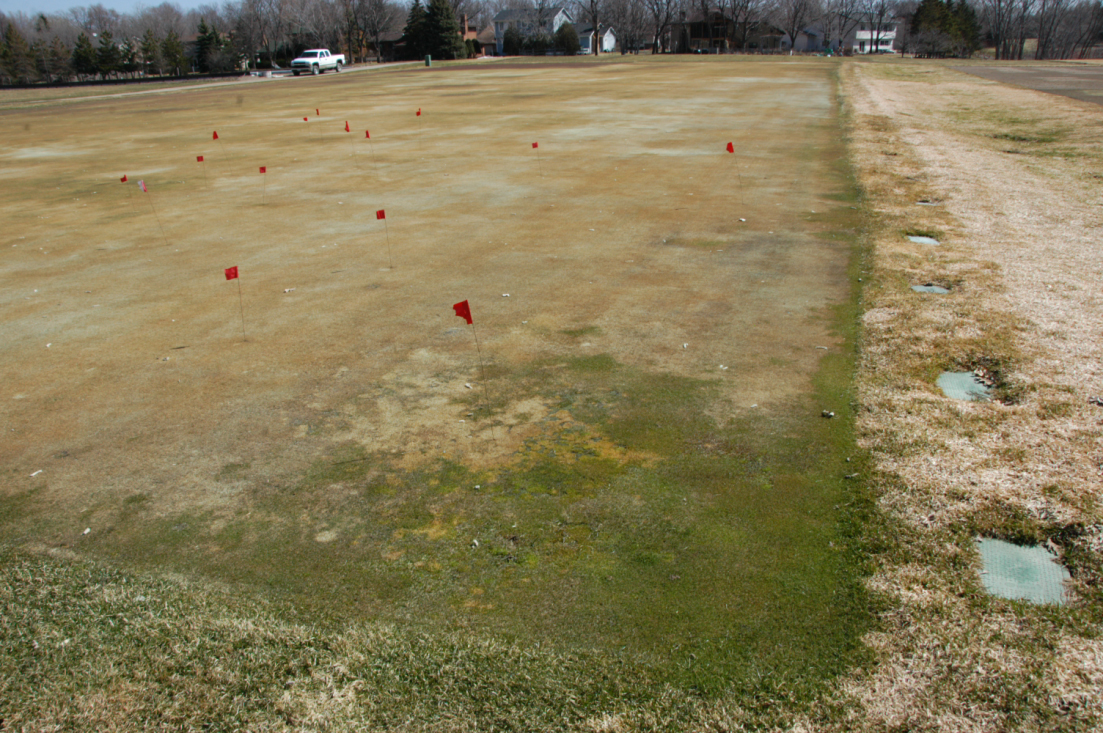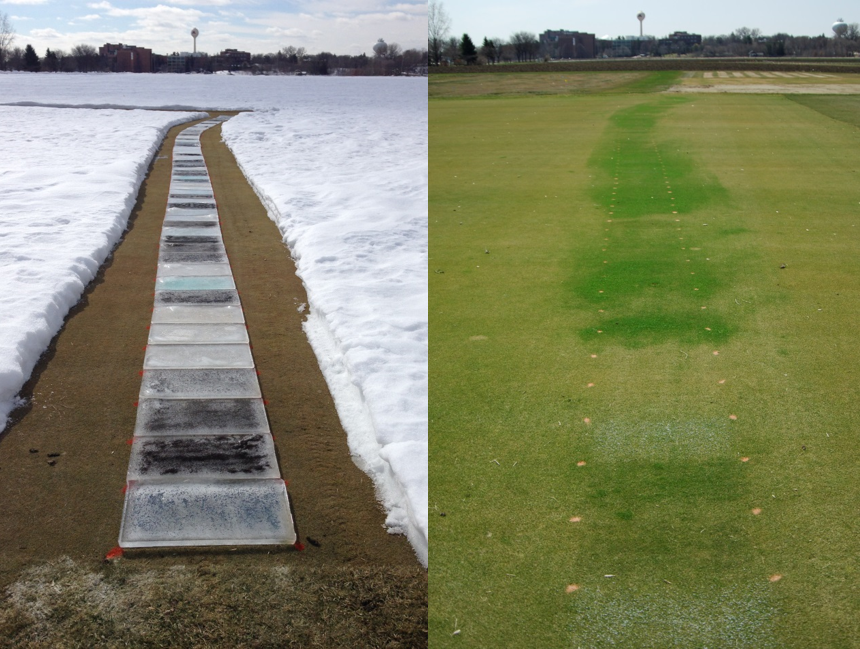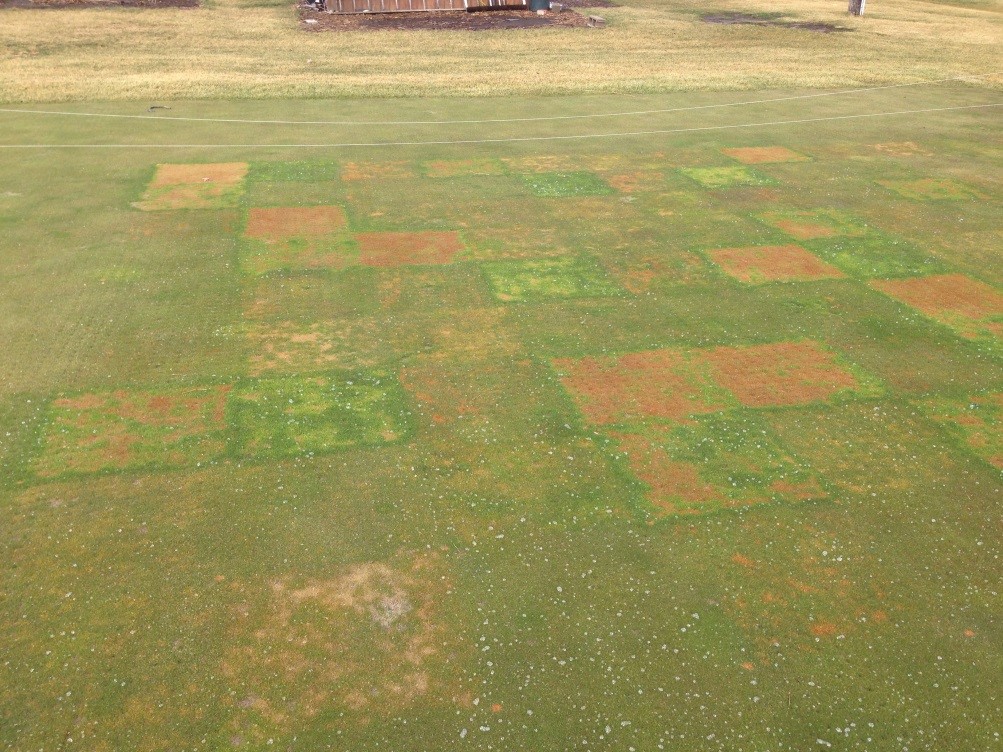By Andrew Hollman
Minnesota experiences winter weather that can vary dramatically from year to year. The 2018 to 2019 winter started early and offered us ice, extremely cold temperatures, and record snowfall for the month of February. The impact that this has on turfgrass won’t be evident until the snow melts and the grass begins to grow. The melt of the snow and regrowth of our research putting greens in the spring of 2011 presented us with grim view. In the fall of 2010, the Twin Cities had warm temperatures and over an inch of rain in late October. An unseasonable warm November had high temperatures in the mid-60s only days before over 8 inches of snow fell. With soil temperatures over 40F in the top 2 inches of soil and warmer temperatures below that, it quickly melted to only a couple inches, but never disappeared completely. Added rain and snow created depths that were up to 24 inches at times and covered the ground until the beginning of April. After 139 days of cover over an unfrozen soil, large sections of our bentgrass putting green appeared to have been severely damaged (Figure 1).
The damage that was experienced wasn’t unique to our research site. Superintendents reported similar damage on uncovered and covered greens. On some greens with impermeable covers, circles of surviving grass surrounded the metal spikes used to secure the covers. We suspected that the spikes created channels for gas exchange, allowing the grass in the vicinity to survive.
Predicting whether ice will cause damage on a putting green is difficult because the conditions under which ice forms, duration of ice cover, species and cultivars all play a part in the potential for ice to be deleterious. Superintendents may choose to remove ice. If ice removal is deemed necessary, mechanical removal is time and labor intensive, and conditions might make certain areas inaccessible. Care also must be taken to ensure the surface below the ice is not damaged. If temperatures and solar radiation are sufficient, another option is to spread dark material on the ice surface to passively melt the ice. If the first two option aren’t feasible, could a third option be to use chemical de-icers?
If you have lived in or driven through a state that uses de-icing chemicals, you have probably seen the damage that salt (sodium chloride) can do to surrounding surfaces or plants. There are a number of different types of de-icers out there that provide different chemicals to deal with ice depending on factors such as temperature, ice thickness, and safety to surfaces, pets, or the environment. Some of them even have names which allude to their safety.
| Chemical De-icing Products | Rate (for ice) | Weights |
|---|---|---|
| Calcium Chloride | 4 oz / yd2 | 27.78 lbs/1000 ft2 |
| Sodium Chloride | 4 oz / yd2 | 27.78 lbs/1000 ft2 |
| Magnesium Chloride | 4 oz / yd2 | 27.78 lbs/1000 ft2 |
| Potassium Chloride | 4 oz / yd2 | 27.78 lbs/1000 ft2 |
| CMA (Calcium Magnesium Acetate) | 4 oz / yd2 | 27.78 lbs/1000 ft2 |
| NAAC (Sodium Acetate) | 4 oz / yd2 | 27.78 lbs/1000 ft2 |
| EnviroMelt (Urea) | 4 oz / yd2 | 27.78 lbs/1000 ft2 |
| Safe Paws (Modified Amide/Glycol Admixture) | 4 oz / yd2 | 27.78 lbs/1000 ft2 |
| Tenderfoot Ice Melter ((Urea and DeFrost (corn steep liquor)) | 4 oz / yd2 | 27.78 lbs/1000 ft2 |
| Ammonium Sulfate | 4 oz / yd2 | 27.78 lbs/1000 ft2 |
We wondered whether any of these products could safely be used to melt ice on a putting green or create holes and allow gas exchange (Table 1). From the marketing information, claims were made on pet safety because they lacked salts which can cause irritation on contact or harm with ingestion. Some of the products also claimed they were gentle on the environment and could even promote growth and vigor for most landscape plants. With closer examination of the active ingredients, we found that many of the products aimed at pet owners were urea based. A larger surprise was that over 12 pounds of nitrogen per 1000ft2 is applied with a single application at the recommend rate. Since this is well over the recommended application rate for water soluble fertilizers, we had some concerns with the potential damage that it could cause.
We conducted preliminary trials with 2-inch-thick man-made blocks of ice placed over ice-free putting green surface in March of 2014 (Figure 2). All of the chemical products were able to create holes though the ice. When the temperatures warmed up and the grass began to grow, there wasn’t any damage to the turf, but there were large patches of lush green grass we attributed to the nitrogen in the urea-based products which was diluted with melt water enough to prevent damage. Although these preliminary results were promising, we needed more information to determine whether these products might cause injury if the conditions were different.
We set up two more trials to examine the effect these chemical de-icers have on an ice-free native (silt loam soil) and USGA (sand based) L-93 creeping bentgrass putting green. We chose an ice-free surface to account for potential damage these products could have if application of products encountered ice-free areas because of topography, variation in ice depth or inadvertent application. The trials were carried out in March 2014 and March 2015 and plots were rated for damage through June of the trial year.
In 2014 and 2015 on the native and USGA green, phytotoxicity ratings for the urea-based products were significantly worse from the control (no de-icer) and the damage that was seen persisted well into the growing season. The phytotoxicity ratings for the non-urea-based de-icers were not significantly different than the untreated control in 2014 on either green. In 2015, differences were seen between the non-urea-based de-icers and the untreated control on both greens (Figure 3). On the native green, differences from the control were seen right away in April. The only products at the labeled rate which were no longer significantly worse than the control for the June phytotoxicity ratings were potassium chloride and ammonium sulfate. On the USGA green, differences from the control were seen for all treatments in April but by June, only the labeled rate of magnesium chloride phytotoxicity ratings remained significantly worse than the untreated control.
The increased damage seen in 2015 over 2014 could have been caused by a week of temperatures above freezing prior to trial application, which may have led to actively growing plants encountering the de-icers. Differences between the two putting greens might have been because of differences in the ability of water to infiltrate and percolate through them. Water infiltration was likely quicker into the sandy soil of the USGA green leading to less exposure to de-icers before they could be flushed through. Although the preliminary results on ice blocks looked promising for non-urea based de-icers, the variability of performance between soil types and years along with potential for lasting damage, suggests caution in their use over ice-covered turf. Although urea based de-icers are marketed as “safer”, the large amount of nitrogen applied for a single application means there is potential for these nutrients to move offsite and pollute waterways or cause excessive growth, and the lasting damage when applied to ice free turf make them a poor choice to melt ice over turf or on impervious surfaces.
Reference
Hollman, A., G. Heineck, K. Frank, S. Bauer, J. Bryan, and B. Horgan. 2017. Effects of de-icing products on putting green turf. International Turfgrass Society Research Journal. 13: p. 256-263. doi:10.2134/itsrj2016.06.0488


